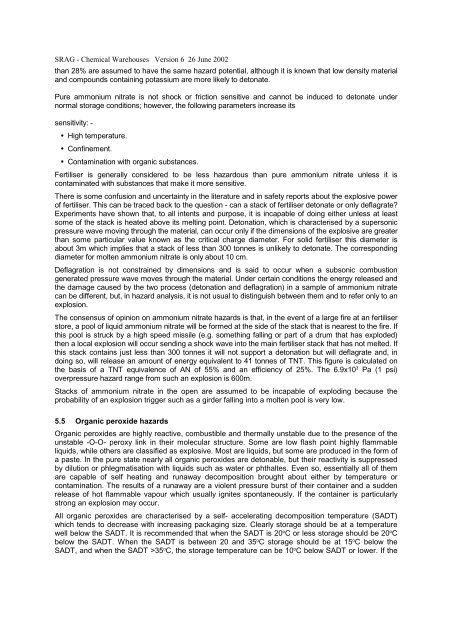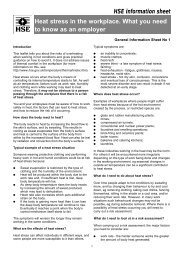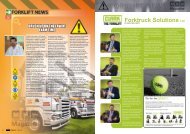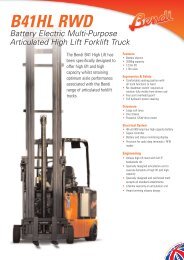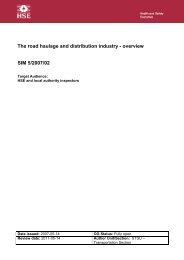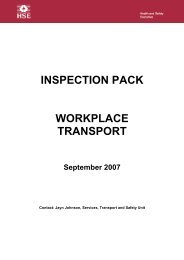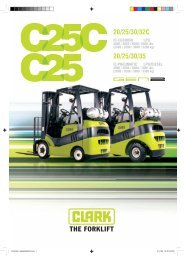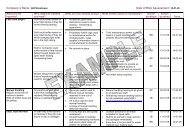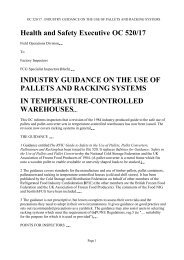Hazards - Forktruck Solutions Ltd.
Hazards - Forktruck Solutions Ltd.
Hazards - Forktruck Solutions Ltd.
You also want an ePaper? Increase the reach of your titles
YUMPU automatically turns print PDFs into web optimized ePapers that Google loves.
SRAG - Chemical Warehouses Version 6 26 June 2002than 28% are assumed to have the same hazard potential, although it is known that low density materialand compounds containing potassium are more likely to detonate.Pure ammonium nitrate is not shock or friction sensitive and cannot be induced to detonate undernormal storage conditions; however, the following parameters increase itssensitivity: - High temperature. Confinement. Contamination with organic substances.Fertiliser is generally considered to be less hazardous than pure ammonium nitrate unless it iscontaminated with substances that make it more sensitive.There is some confusion and uncertainty in the literature and in safety reports about the explosive powerof fertiliser. This can be traced back to the question - can a stack of fertiliser detonate or only deflagrate?Experiments have shown that, to all intents and purpose, it is incapable of doing either unless at leastsome of the stack is heated above its melting point. Detonation, which is characterised by a supersonicpressure wave moving through the material, can occur only if the dimensions of the explosive are greaterthan some particular value known as the critical charge diameter. For solid fertiliser this diameter isabout 3m which implies that a stack of less than 300 tonnes is unlikely to detonate. The correspondingdiameter for molten ammonium nitrate is only about 10 cm.Deflagration is not constrained by dimensions and is said to occur when a subsonic combustiongenerated pressure wave moves through the material. Under certain conditions the energy released andthe damage caused by the two process (detonation and deflagration) in a sample of ammonium nitratecan be different, but, in hazard analysis, it is not usual to distinguish between them and to refer only to anexplosion.The consensus of opinion on ammonium nitrate hazards is that, in the event of a large fire at an fertiliserstore, a pool of liquid ammonium nitrate will be formed at the side of the stack that is nearest to the fire. Ifthis pool is struck by a high speed missile (e.g. something falling or part of a drum that has exploded)then a local explosion will occur sending a shock wave into the main fertiliser stack that has not melted. Ifthis stack contains just less than 300 tonnes it will not support a detonation but will deflagrate and, indoing so, will release an amount of energy equivalent to 41 tonnes of TNT. This figure is calculated onthe basis of a TNT equivalence of AN of 55% and an efficiency of 25%. The 6.9x10 3 Pa (1 psi)overpressure hazard range from such an explosion is 600m.Stacks of ammonium nitrate in the open are assumed to be incapable of exploding because theprobability of an explosion trigger such as a girder falling into a molten pool is very low.5.5 Organic peroxide hazardsOrganic peroxides are highly reactive, combustible and thermally unstable due to the presence of theunstable -O-O- peroxy link in their molecular structure. Some are low flash point highly flammableliquids, while others are classified as explosive. Most are liquids, but some are produced in the form ofa paste. In the pure state nearly all organic peroxides are detonable, but their reactivity is suppressedby dilution or phlegmatisation with liquids such as water or phthaltes. Even so, essentially all of themare capable of self heating and runaway decomposition brought about either by temperature orcontamination. The results of a runaway are a violent pressure burst of their container and a suddenrelease of hot flammable vapour which usually ignites spontaneously. If the container is particularlystrong an explosion may occur.All organic peroxides are characterised by a self- accelerating decomposition temperature (SADT)which tends to decrease with increasing packaging size. Clearly storage should be at a temperaturewell below the SADT. It is recommended that when the SADT is 20 o C or less storage should be 20 o Cbelow the SADT. When the SADT is between 20 and 35 o C storage should be at 15 o C below theSADT, and when the SADT >35 o C, the storage temperature can be 10 o C below SADT or lower. If the


